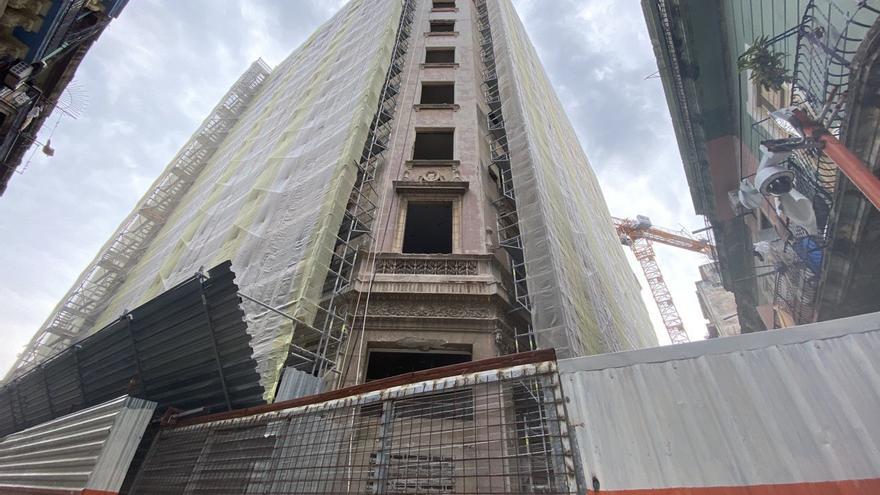
![]() 14ymedio/EFE, Havana, 12 February 2020 — Cuba will continue to build hotels as a long-term strategy despite the decline in tourism. The Minister of Tourism, Juan Carlos García, answered the question that many ask themselves, one that, without a doubt, he wanted to answer, since it was asked this Tuesday during his appearance on the Roundtable program on Cuban Television.
14ymedio/EFE, Havana, 12 February 2020 — Cuba will continue to build hotels as a long-term strategy despite the decline in tourism. The Minister of Tourism, Juan Carlos García, answered the question that many ask themselves, one that, without a doubt, he wanted to answer, since it was asked this Tuesday during his appearance on the Roundtable program on Cuban Television.
The Cuban official who heads up the activity said that Cuba would never received more than four million tourists if, in the 90s, Fidel Castro and his brother Raul had not decided to develop the sector with a program that included, in addition to Havana and Varadero, Holguin and the Cuban Keys.
Thus, even though the latest figures for the last year showed a 9.3% drop in foreign visitors, the Government will continue to focus on increasing the capacity of hotels and related services.
“In the beginning the country was marketed as a sun and beach destination, and the investment efforts were focused on this type of tourism. But today the expectations of the tourists go beyond that, they want to enjoy the hospitality of the Cuban people, their culture” said Garcia.
“For the growth of tourism in the capital, a more up-to-date hotel infrastructure was required. The hotels we build today are high-tech, coinciding with what the country needs. We work with solar panels, saving lighting, even when we are in a highly automated process,” he added.
In addition, competition in the region, according to the minister, is very strong, so investments will continue.
For this year, tourism authorities have set a goal of 4.5 million international visitors this year and hope to reverse the decline suffered in 2019 with the growth of the market in Russia and the recovery of traditional numbers from European countries.
“It is not the first time that tourism has declined in Cuba. That happened earlier in 2001, 2007 and 2008, but we have had the possibility of recovering. We are sure that we are going to reverse this situation,” he said.
Garcia recalled that this decline came after the strengthening of the economic embargo measures applied by the United States Government, such as the suspension of cruises from that country, as well as things like the bankruptcy of tour operators such as the British Thomas Cook.
The Russian market went from tenth to fourth place at the end of 2019, during which it grew by 30%, sending a record 178,000 travelers to Cuba; and this year the Cuban Tourism Fair will be dedicated precisely to the Eurasian nation as a guest of honor.
The highest authority of the sector outlined other measures to recover the growth of previous years and rescue of tourism, including from events and looking at traditional markets such as Spain, Germany, France, Italy and Great Britain, along with the incorporation of new markets and continuing the investment in hotel rooms and facilities.
Other lines of growth to which the Cuban market aspires are the increase in the share of tourism by Cubans, which the authorities are focused on. In 2019, 600,000 more Cuban clients were accommodated compared to the previous year and the chains are making special offers that so that these visits will continue to rise. In Varadero, the minister argued, there were more than 7,000 national customers at the end of the year.
“We are engaged in the north of Holguin, in a project that includes eight campsites, four of which will be inaugurated in 2020, always taking advantage of the natural beauty of the environment,” he said.
Other strategies cited were the increase in internal connections in the country, seeking the Chinese market as a potential large source of tourists, and offsetting the embargo with a package of unspecified measures.
In addition, the minister announced that the cruise sector is not being ignored, despite the fact that the main market — cruiseships from the US — is now prohibited.
Although in 2019 the bar was set at the reception of 5.1 million foreign visitors, that official forecast was revised downwards, first to 4.7 and finally to 4.3 million.
But at the end of 2019 the registered figure was 4.27 million tourists.
Tourism is Cuba’s third source of income behind remittances and the sale of professional services abroad, contributing 10% to gross domestic product (GDP) and generating approximately half a million jobs, according to official
___________________
COLLABORATE WITH OUR WORK: The 14ymedio team is committed to practicing serious journalism that reflects Cuba’s reality in all its depth. Thank you for joining us on this long journey. We invite you to continue supporting us by becoming a member of 14ymedio now. Together we can continue transforming journalism in Cuba.
